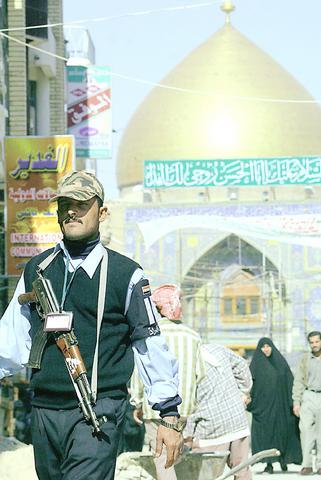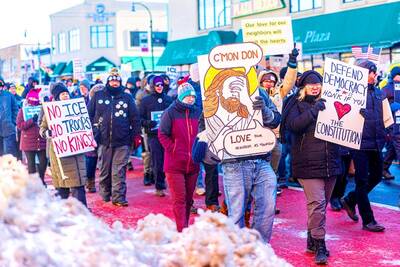The US military has learned from people close to Iraq's most powerful spiritual leader that accounts of an assassination attempt against him on Thursday were "a fabrication," a senior military official said on Friday.
Contradictory reports about a possible attack on the cleric, Grand Ayatollah Ali Husseini al-Sistani, in the southern holy city of Najaf continued to circulate throughout the country.
The US official said the military had no further information on how reports of an attack began. Early indications of an attack came from the spokesman for a prominent politician and from security guards for the ayatollah, the reclusive leader of Iraq's 15 million Shiites.

PHOTO: AFP
The official added, though, that the US military did not have "eyes on the ground to say definitely what happened."
The politician, Mowaffak al-Rubaie, an independent Shiite member of the Iraqi Governing Council, said on Friday that he could not confirm or deny reports of an assassination attempt. On Thursday night, his spokesman, Ali al-Shapoot, said that there had been an attack on the ayatollah, who is calling for immediate direct elections in Iraq, against the wishes of the administration of US President George W. Bush.
Some security officials for al-Sistani also told news organizations on Thursday night that there had been an attempt on the ayatollah's life. Radio Sawa, a regional station operated by the US government, reported earlier in the day that threats had been made against him, and that the cleric had moved to a safe location. The radio report was possibly the first public mention of a threat of some kind.
Rubaie, a neurologist, said on Friday that "an incident" had taken place on Thursday morning that involved al-Sistani. When Rubaie went to the cleric's small home in Najaf in the afternoon, he said, the ayatollah appeared "fit" and "not shaken."
"There was a heightened sense of security at his house," Rubaie said, adding that a small metal gate had been erected at the entrance to the narrow alleyway leading to the ayatollah's home.
The mouth of the alleyway, just blocks from the golden-domed Shrine of Ali, one of the holiest pilgrimage sites for Shiites, is usually watched by a couple of plainclothes guards. Al-Sistani, 73, rarely leaves his home. He occasionally receives worshipers, politicians and other religious leaders.
When asked how he had learned about the incident, Rubaie said he did not want to answer and abruptly cut off the interview.
There appeared to be some confusion on Friday among al-Sistani's representatives as to what had happened the previous day. Nooraddin Mousawi, the brother of the ayatollah's representative in Baghdad, said on Friday that the Baghdad office could not confirm or deny whether there had been an attack and was awaiting word from Najaf. Later, the office in Najaf released a statement saying that "there was absolutely no truth in these reports."
Hamid al-Kaffaf, the ayatollah's representative in Lebanon, told Al Jazeera, the Arab-language television network, that no one from the ayatollah's office had confirmed the assassination attempt. He said the ayatollah had increased security precautions in the last two weeks because his office had received "confused information" that there might be attacks on him.
He added that the people spreading rumors of the attack were trying to interfere with the imminent visit of a U.N. team expected to assess the feasibility of direct elections for a transitional national assembly. Al-Sistani has called for such elections by June 30.

Shamans in Peru on Monday gathered for an annual New Year’s ritual where they made predictions for the year to come, including illness for US President Donald Trump and the downfall of Venezuelan President Nicolas Maduro. “The United States should prepare itself because Donald Trump will fall seriously ill,” Juan de Dios Garcia proclaimed as he gathered with other shamans on a beach in southern Lima, dressed in traditional Andean ponchos and headdresses, and sprinkling flowers on the sand. The shamans carried large posters of world leaders, over which they crossed swords and burned incense, some of which they stomped on. In this

Near the entrance to the Panama Canal, a monument to China’s contributions to the interoceanic waterway was torn down on Saturday night by order of local authorities. The move comes as US President Donald Trump has made threats in the past few months to retake control of the canal, claiming Beijing has too much influence in its operations. In a surprising move that has been criticized by leaders in Panama and China, the mayor’s office of the locality of Arraijan ordered the demolition of the monument built in 2004 to symbolize friendship between the countries. The mayor’s office said in

‘TRUMP’S LONG GAME’: Minnesota Governor Tim Walz said that while fraud was a serious issue, the US president was politicizing it to defund programs for Minnesotans US President Donald Trump’s administration on Tuesday said it was auditing immigration cases involving US citizens of Somalian origin to detect fraud that could lead to denaturalization, or revocation of citizenship, while also announcing a freeze of childcare funds to Minnesota and demanding an audit of some daycare centers. “Under US law, if an individual procures citizenship on a fraudulent basis, that is grounds for denaturalization,” US Department of Homeland Security Assistant Secretary Tricia McLaughlin said in a statement. Denaturalization cases are rare and can take years. About 11 cases were pursued per year between 1990 and 2017, the Immigrant Legal Resource

‘RADICALLY DIFFERENT’: The Kremlin said no accord would be reached if the new deal with Kyiv’s input did not remain within the limits fixed by the US and Russia in August Ukrainian President Volodymyr Zelenskiy is to meet US President Donald Trump in Florida this weekend, but Russia on Friday accused him and his EU backers of seeking to “torpedo” a US-brokered plan to stop the fighting. Today’s meeting to discuss new peace proposals comes amidst Trump’s intensified efforts to broker an agreement on Europe’s worst conflict since World War II. The latest plan is a 20-point proposal that would freeze the war on its current front line, but open the door for Ukraine to pull back troops from the east, where demilitarized buffer zones could be created, according to details revealed by